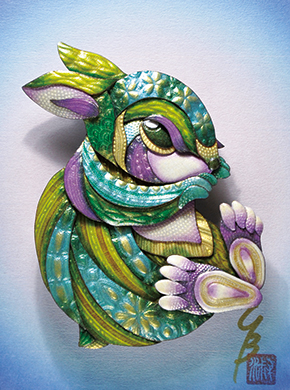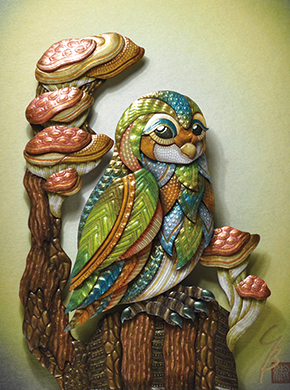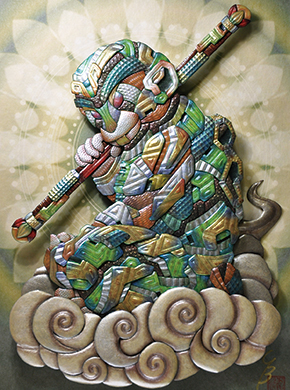
Amazing feeling of materials
Ukitoegami
Resembling a combination of materials such as metal and leather, ukitoegami has a unique texture unbelievably made of paper.
A layer of paper is finely embossed with vivid color and luster. The semi-three-dimensional works have a mysterious vitality and aesthetic charm.
Shuku BANZAI is a young and promising ukitoegami artist that keeps gaining fans.
Before reaching this technique, she spent many years learning about the characteristics of paper and trying to convert its weaknesses into strengths.

Shuku Banzai
Born in Tokyo in 1983. After graduating from Department of Cross-Cultural Studies, Faculty of Humanities, Seikei University in 2006, Ms. Banzai entered and worked for a company before exhibiting at Art Fair Tokyo 2013, beginning her career as an artist. She held Ukitoegami-ten, a personal exhibition, in 2014. Her creative touch attracted attention and subsequently she has exhibited her works, mainly at department stores, while energetically creating new works.
By logically overcoming the challenges of paper and continuing to evolve, I will create works that will amaze the audience.
Creating finely-patterned concave and convex shapes on small cuts of paper expresses a texture like metal, pottery or leather. Combining multiple layers results in flexible curves that are unique to living creatures that vividly represent liveliness and vitality. Shuku BANZAI mixes materials with different properties. Thus, her works convey something new. The organic combination of materials also conveys a controlled sense of unity.
“I mix things that are totally irrelevant and contradictory to each other. This might be the core of my creative work,” says Ms. Banzai. “What can be made from a combination of the softness of paper and the hardness of metal? I have always had this kind of curiosity.” In pursuit of a non-paper-like texture, Ms. Banzai has tried ten different materials, including metal, leather, cloisonne, rock, plastic, pottery, wood grain, rust, scale and shell. The small embossed parts are combined at will in accordance with the characteristics of the object, and become a unique art form which the artist named ukitoegami. “I like to study the use of paper to represent different textures. I still spend a lot of my time on it. Discoveries from these studies are incorporated into my next work. Repeating the cycle will continue to evolve my works.” It is made of paper but is no longer paper. Ms. Banzai’s works keep improving through her tireless quest.

Peace of Flower Buds (2017)

A Guide for Someone who Wishes (2017)

With a Dauntless Spirit (2016)

Shine of a Thin Fog (2017) Ito Wokashi (2016)
From childhood, Ms. Banzai has enjoyed drawing pictures. Until high school she continued her hobby of creating works that mainly consisted of illustrations. In university she joined the Faculty of Humanities. Her career is different from other artists, most of whom are arts graduates. “At university, I was in an art club and engaged in activities such as organizing exhibitions, but I never dreamed of being an artist. Most of all, I didn’t want to avoid the job search because of what I enjoyed, drawing pictures, so I joined a company after graduating,” says Ms. Banzai. She began to work for a company, but her appetite for creation lingered. She left the company after one year and studied drawing at an art preparatory school as well as web design and graphic design at a vocational college. During that time she also worked part-time in a number of jobs. After many twists and turns, she took her first step as an artist. “It took a lot of time, but every moment was necessary for me. Everything I felt and experienced in my career has become a small piece of paper layered one on top of another, resulting in my art work. I have walked many different paths. Hopefully I represent something similar to the profundity of life through my works.”
While working part-time, Ms. Banzai fully started her career as an artist. In 2012, she decided to exhibit at the art event Design Festa. As she pursued her original art, she chose tracing paper, a material she had used in university. “I remembered that I had enjoyed something that looks transparent and lustrous, so I came up with the idea of using tracing paper to combine the transparency of paper with the texture of metal in my works.” She spent the following month on trial and error. She experienced difficulties and repeatedly called on her own ingenuity before reaching the initial form of her current technique.
Process of making Ms. Banzai’s ukitoegami

After drawing the sketches, number them by considering the order of layering.
Decide on the number of sheets to layer and the parts to thicken before making patterns to be embossed on the paper and adding them to the design.

Beforehand, prepare the other sheets of paper with resin or an equivalent. Then choose ones that will complement the design in terms of color and texture. Use a light table to trace the sketches onto the sheets of paper.

Cut the sheets of paper along the traced lines. About 90 parts were made in this process.

Use different types of metal pencils to create fine and beautiful concave and convex shapes on both sides of each part.

Using several colors of acrylic paint to repaint the parts helps to intensify the intended color. Pay careful attention not to have uneven painting or remaining handwriting.

Paste the small parts together in accordance with the design. Apply varnish and luster to finish the process.


Life Span of Hermit (2016) Become the Wind, with a Flourishing Light (2016)

Traces of Encounter (2016) Who Knows Grace (2016)
By her own admission, Ms. Banzai is careful about doing anything. Next, she set out to improve her works with the aim of making them last longer. “I needed to do something to keep my works stable for a longer period so that my fans could appreciate the works for as long as possible. I realized that this is the responsibility of the artist. From that point on, I repeatedly tried to identify the weaknesses of paper and to find solutions to such problems,” recalls Ms. Banzai. To overcome the weakness of tracing paper, namely its susceptibility to humidity, she coated her works with a waterproof resin and pigment ink or acrylic paint, which mixes well with resin. Embossing the different parts prevents the paper from warping. To minimize discoloration, she chooses lightfast pigment ink or acrylic paint and applies varnish as a finish, which would effectively block UV rays. To make the works more lightweight, the amount of attached parts are decreased and the folding and layering is improved. The originality of Ms. Banzai’s works lies in the careful analysis of the characteristics of paper and transforming its weaknesses into strengths. “As I explored methods for expanding the scope of my representation of texture, I realized that the fibers of washi could be likened to metal, wood grain, leather and more.
Applying resin to a layer of tracing paper and washi led to my original texture, which is made of paper and but is no longer paper.” Ms. Banzai chose the washi named Tosa tengujoshi. Arguably the world’s thinnest kind, it is also used to restore works of art and cultural properties. Using the very thin and tough washi helps Ms. Banzai’s art to evolve to a higher level.
The works of Ms. Banzai gained much attention at Art Fair Tokyo 2013 and 2014. Many galleries invite her to exhibit. The realm of her activity has extended to exhibitions at Tokyo department stores and to solo exhibitions. Today, she is increasingly gaining recognition and popularity as a very creative artist. “The essence of my art is to amaze the audience. Hopefully I will keep incorporating new and traditional Japanese materials to create strongly memorable works,” says Ms. Banzai. Keep your eyes on her evolution.

INFORMATION Ms. Banzai’s works will be exhibited at:
KOWAII
■Period: Jan. 29 (Mon) – Feb. 10 (Sat), 2018 *Closed on Sundays and holidays
■Venue: art data bank (1st floor of Taiyo Building 5, 7-10-8 Ginza, Chuo-ku, Tokyo)
■Hours open: 11:00 a.m. – 7:00 p.m. ■Contact: Hakkendo Inc.
■TEL: 03-6453-2987
*Ms. Banzai is also scheduled to join a group exhibition in a Tokyo department store in early January 2018.
